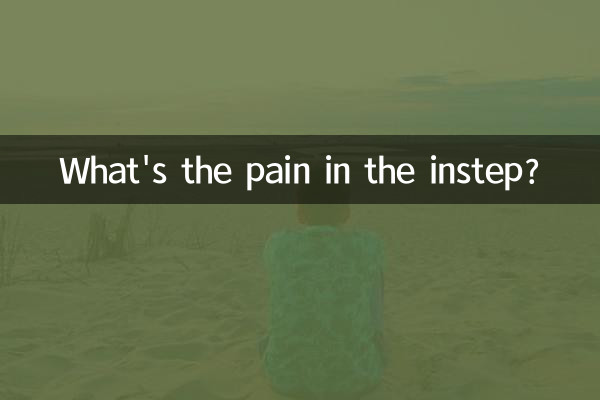What's the pain in the instep?
Pain instep compression is a common symptom that can be caused by a variety of reasons. Recently, popular discussions on instep pain across the Internet have focused on sports injuries, disease factors and daily habits. This article will combine the hot topics over the past 10 days to structure the possible causes, symptoms and response measures for instep compression pain.
1. The correlation between recent hot topics and instep pain

| Hot Topics | Relevance | Discussion hot topic |
|---|---|---|
| Sports injury prevention | Running, rope skipping and other exercises may cause instep strain | high |
| Gout diet control | Uric acid crystal deposition may cause instep pain | middle |
| Diabetic foot care | Neuropathy may manifest as abnormal sensation in the foot | middle |
| Foot health care methods | Tips for relieving instep pain, such as massage and foot soaking | high |
2. Common causes of instep compression pain
According to recent discussions on medical and health topics, instep compression pain may be caused by the following reasons:
| Cause classification | Specific symptoms | Typical Symptoms |
|---|---|---|
| Sports Injury | Tendonitis, stress fractures | Exercise, local swelling |
| Metabolic diseases | Gout, diabetes | Sudden severe pain or persistent sting |
| Skeletal problems | Abnormal arch, arthritis | Stiff in the morning, limited movement |
| Neuropathy | Peripheral neuritis | Burning sensation, numbness |
| External compression | Shoes too tight | Local tenderness, red skin |
3. The self-diagnosis method that has been discussed recently
On social platforms, there are enthusiastic discussions on self-diagnosis methods for instep pain. Here are several methods that have attracted more attention:
1.Pressure test method: Press the painful area with your fingers to observe the changes in the degree and range of pain. Recently, a health blogger has shared that severe pain in the local fixation point may indicate a fracture, while diffuse pain may be tendinitis.
2.Activity check: Active dorsiflexion and plantar flexion of the feet to feel the pain changes. A sports medicine expert demonstrated in the video that aggravated pain during activities is mostly related to sports injuries.
3.Temperature observation method: Redness, swelling, heat and pain are typical manifestations of gout. Several gout patients communities have been discussing how to distinguish gout from other foot pain in the past week.
4. Recent suggestions from medical professionals
According to the content published by medical and health accounts in the past 10 days, professionals’ suggestions for instep compression pain are mainly focused on the following aspects:
| Situation classification | Suggested measures | Indications for medical treatment |
|---|---|---|
| Mild pain | Rest, ice, and raise the affected limb | Lasts for 3 days without remission |
| Moderate pain | Secure with elastic bandage | Influencing daily walking |
| Severe pain | Seek medical examination immediately | Accompanied by swelling and fever |
| Chronic pain | Professional Foot Evaluation | Lasts for more than 2 weeks |
5. Popular suggestions for preventing instep pain
In recent healthy lifestyle content, the discussion on preventing instep pain mainly focuses on the following aspects:
1.Choose the right shoes: Many sports bloggers recommend choosing sports shoes with good arch support, especially when performing high-intensity exercise.
2.Warm up before exercise: In recent fitness topics, experts emphasize the importance of foot warm-up movements, especially for running and jumping.
3.Control uric acid levels: In the discussion on gout prevention and treatment, reducing high-purine food intake has been mentioned many times, especially seafood and beer.
4.Regular foot relaxation: Health account recommendations are to perform simple foot massage and stretching exercises every day to relieve foot muscle tension.
6. When do you need medical treatment?
According to the recent consensus on medical and health content, seek medical treatment in a timely manner when the following situations occur:
1. The pain continues to worsen, affecting normal walking
2. Accompanied by obvious swelling, redness or fever
3. Have a history of trauma and suspected of fracture
4. Systemic symptoms such as fever and fatigue
5. Patients with underlying diseases such as diabetes have abnormal foot sensation
In short, instep compression pain may be caused by a variety of reasons, and the recent hot topics of online discussions are mainly focused on exercise protection and metabolic disease management. Correctly identify the cause of the pain, take appropriate response measures, and seek medical treatment in a timely manner when necessary, so as to effectively solve the problem of instep pain.

check the details